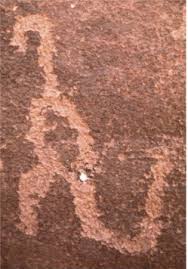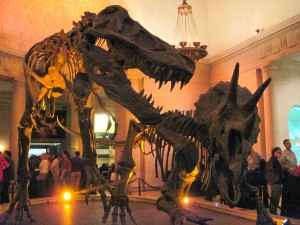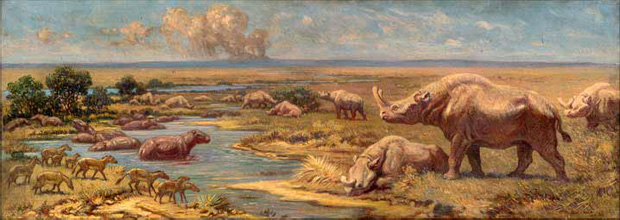Based upon material collated by Dr.Immanuel Velikovsky and published in Kronos journal
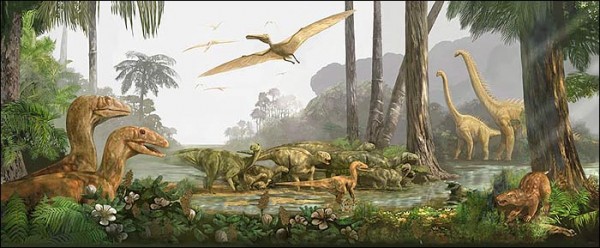 Dinosaur fossils have been found in the Laramie basin in Wyoming together with land plants “remarkably modern in their aspect”; these land plants suggest a much more recent age than the Cretaceous, said to have ended about 70 million years ago. The plants were referred by paleo-botanists to at least the Tertiary epoch, or the Age of Mammals.
Dinosaur fossils have been found in the Laramie basin in Wyoming together with land plants “remarkably modern in their aspect”; these land plants suggest a much more recent age than the Cretaceous, said to have ended about 70 million years ago. The plants were referred by paleo-botanists to at least the Tertiary epoch, or the Age of Mammals.
“The Laramide group has given rise to one of the two most prolonged controversies in the history of American geology.” [C.O. Dunbar, Historical Geology (1949), p. 375.]
But the paleo-zoologists persisted in ascribing the fossils along with the plants to the Cretaceous.
In the red sandstone wall of Hava Supai Canyon in the region of the Grand Canyon in northern Arizona were discovered figures of animals cut by some prehistoric man. “The fact that some prehistoric man made a pictograph of a dinosaur on the walls of this canyon upsets completely all of our theories regarding the antiquity of man.” [Dunbar]
“The fact that the animal is upright and balanced on its tail would seem to indicate that the prehistoric artist must have seen it alive.” [Dunbar]
Dinosaurs were in the vicinity, as is established by footprints discovered not more than one hundred miles from the picture.
“Dr. Ales Hrdlicka, President of Anthropology, has given a lecture on these discoveries. Though his facts seem almost fantastic, they demand attention. They are actually nothing more or less than an image of a dinosaur supporting itself on its hind legs and balanced by its enormous tail. And a second drawing shows a saurian attacking a man. … the third drawing portrays a human figure beside a mastodon.” [Samuel Hubbard, Discoveries relating to prehistoric man by the Doheny Scientific Expedition in the Hava Supai Canyon, Northern Arizona (1927), p. 5. E. George, referring to these drawings in The Adventures of Mankind (1931)]
The paleontologist’s scheme requires the extinction of dinosaurs sixty to seventy million years before man appeared on the Earth.
“Either man goes back in Geologic time to the Triassic Period, which is millions of years beyond anything yet admitted (assigned the period 200-240 million years ago), or else there were ‘left over’ dinosaurs which came down into the age of the mammals. Yet even this last conclusion indicates a vast antiquity.” [Hubbard]
What kind of man was the artist? “He used tools. He had the patience to chip an outline in hard stone with a crude flint and he had the perseverance to finish the job. He had an eye for form and a sense of proportion. He had the good judgment to select a medium which has preserved his work.” [Hubbard]
Close to the picture of the dinosaur appears a drawing of an elephant attacking a large man. Elephants were not found in America when it was discovered by Columbus, but remains of elephants, “are very common all over North America, and they are found from Alaska to Mexico. Three species are represented: the mammoth, the mastodon and the imperial elephant (elephas imperator) of California.” [Hubbard]
On the wall of the Canyon is a representation of the elephant. Restored skeletons stand fourteen feet high (almost 5 m.). The inference has to be that the artist was familiar with his subject. Next to these pictures an ibex is drawn; prehistoric pictures of the ibex, rather artistically executed, are also found in other places in the region of the Grand Canyon.
“The interesting thing about this is that no ibex, not even fossil ones, have ever been found in America. These drawings would seem to indicate that they must have been a common animal in the Grand Canyon region, in the prehistoric past.” [Hubbard]
“Must we not readjust many of our ideas regarding the antiquity of man, and his contact with the prehistoric animals … ?”
It is not enough that a prehistoric man depicted animals long extinct and even of antediluvial origin. On the same wall where dinosaur, elephant, and ibex appear, the artist left pictographs or some inscription of prehistoric times.
“The most remarkable of these was a row of symbols, deeply incised, which resembled the Greek sign of Mars showing shield and spear. … The ‘desert varnish’ had commenced to form in the cut, indicating an unbelievable antiquity.”
If the man knew how to express himself not only in pictures but also in writing, then the term “prehistoric” is hardly justified.
In 1926 a stone bearing an inscription in characters similar to those of the Supai Canyon was found near Granby, Colorado.
“The sculptured stone … shows, carved in high relief, the figures of two dinosaurs and an elephant. … The dinosaurs suggest either the brontosaurus or the diplodocus.” [Hubbard]
Human beings did not exist in the age of the reptiles; if they did exist, they were not literate people. Or were they? Note: Human footprints and dinosaur tracks have (also) been found in close proximity in the Glen Rose area of North-Central Texas.
Were all dinosaurs reptiles?
The antiquity of the geological strata in which fossils are found is measured by tens and hundreds of millions of years. However, it is not impossible that not tens of millions of years lay between the full extinction of the large Dinosauria and our age, but only some thousands of years. Is it possible for cataclysms or catastrophes to do in only hours or weeks what it is claimed evolution would require millennia to accomplish? Are we so convinced of prevailing opinion so as to exclude any other possibility?
The huge extinct animals, dinosaurs, are classified as reptiles, and their time was first termed the Age of the Reptiles. It was supposed that in this early age no mammals existed; then skeletons of small wolf-like animals were discovered together with the bones of dinosaurs.
Brontosaurus (sometimes known as Apatosaurus) is classified as one of the amphibious dinosaurs. It is more than sixty feet long and stands fourteen feet high. It has upright legs, with five tarsal bones and five digits on its feet, a roomy chest enclosed by well-curved ribs and should-blades, a large pelvis with a wide aperture; the teeth of this animal are confined to the front of the jaw. Brontosaurus is estimated to have weighed thirty tons.
Reptiles are crawling creatures and do not have upright legs; the four legs of the brontosaurs are unlike the legs of reptiles. Reptiles have a narrow pelvis, through the aperture of which they lay eggs; they do not bear their living young. The large pelvis of Brontosaurus suggests that this monster might have given birth to its young and did not lay eggs.
In 2001, Mike Caldwell of the University of Alberta, Canada, was examining a mosasaur fossil in the Museum of Natural History in Trieste, Italy. “As soon as I examined it I knew we had an important discovery. In front of me was a mosasaur with embryos – it had tiny little versions of the adults lined up in its belly,” he says.
In 2004 came evidence that a group ancestral to the plesiosaurs, the keichousaurs, also gave birth to live young. As a result, researchers now think that plesiosaurs must also have been viviparous (Nature, vol 432, p 383). “Live birth allows you to get much bigger because you don’t need to come into shallow water or make your way onto land to lay eggs,” says Caldwell. “If you can give birth in water then you can colonise the oceans of the planet” (Proceedings of the Royal Society of London B, vol 268, p 2397).
Diplodocus, another gigantic amphibious dinosaur, may also have been a mammal; likewise Triceratops, with a large pelvis, too, could be a mammal, not a reptile.
“To the lay observer of the many restorations which we have of the long-vanished forms, tinged perhaps in part by the artist’s knowledge of existing types, they do in frequent instances correspond so closely with existing mammals, notably Triceratops with the rhinoceros, that knowledge of their true place in nature cannot be assumed as understood.”
[E.H. Colbert, Dinosaur Book, the : The Ruling Reptiles And Their Relatives, (American Museum of Natural History, N.Y., 1945), p. 58]
However, Lull also says: “The ceratopsians now appear to have been definite egg-layers. “One dinosaur that is unquestionably associated with its eggs is the small Mongolian Protoceratops. It is significant that the eggs are very large — far larger relatively than those of reptiles — so the offspring began life larger than many contemporary mammals and lizards.” [ R. S. Lull in “Organic Adaptations to Environment,” by G.E. Nichols, et al. “Dinosaurian Climatic Response” (Yale Univ. Press, 1924), pp. 225-226: see Desmond, p. 202 and R.T. Bakker, “Dinosaur physiology and the origin of mammals”, Evolution, 25 (1971), pp. 636-658.]
Triceratops may still have been a mammal, however, since a present day group of mammals — the monotremes — do lay eggs. The duckbill platypus is the most typical and best known of the monotremes.
The theriodont, a stout-body animal, skeletons of which have been found mainly in South Africa, is also regarded as a reptile of the Age of Reptiles. Not only did it carry its body on upright legs, but its teeth were differentiated into incisors, canines, and molars, as is the case in mammals, but not in reptiles.
“One of the most striking features in the skull of the theriodonts was the specialization of the teeth. In most reptiles the teeth are more or less alike, and they keep coming in during the life of the animal as fast as their predecessors are worn away or broken. In the theriodonts, however, there were some small front teeth, evidently for chewing and grinding, and between them some elongated, dagger-like teeth, evidently for slashing and tearing. Here we see an exact counterpart of the front incisors, the long pointed canines, and the grinding teeth (the pre-molars and molars) of the mammals.” [Colbert]
“It is not however the evidence of the skull and teeth alone that points to the direct descent of mammals from the theriodont reptiles. For in these remarkable reptiles, the vertebrae of the backbone, the shoulder-blade, the hip bones, the limbs and the feet, all show many characteristics that clearly foreshadowed the typical mammalian plan.” [Colbert]
It is conceivable that mammals and reptiles have been erroneously categorised in the same class Dinosauria. Camptosaurus, Tyrannosaurus, and Trachodonare are clearly not mammals; the difference between their narrow pelvis and the wide pelvis of Brontosaurus is obvious even to non-students of paleontology. The latter may possibly have given birth to living creatures, who nursed at their udders; the former laid eggs.
If only the fossils of whales had been found, and the living animal were not known, the form of the skull with jaws and teeth, its body skeleton and tail, would suggest that it was a fish and not a mammal. But whales larger than the largest dinosaurs are found alive, and we know that they are mammals.
No fossil eggs of the brontosaur have been found; but fossil eggs of a narrow-pelvis dinosaur have turned up, for instance, in the Asian Gobi Desert.
What was the cause of the extinction of the Dinosaurs?
Popular theories not withstanding, it is not known for certain what was the cause of the extinction of the dinosaurs. Did they exterminate one another? Some were carnivorous; the tyrannosaur, with sharp curved claws, sharpened teeth, little forefeet and narrow pelvis, or the allosaur, with bones hollow like those of birds. They fought with the herb-eating Brontosaurus and Diplodocus, attacking with claws and sharp teeth. Some of their skeletons were found in a position that suggests a battle. In the hall of the Dinosauria of the Jurassic period, in the American Museum of Natural History, the final scene of such a battle is reconstructed, showing a carnivorous dinosaur — Allosaurus — tearing the carcass of the fallen brontosaur.
What was the weapon of Diplodocus and Brontosaurus? These animals seventy and eighty feet long had no horns, no claws, and no teeth suited for offense of defense.
“They were apparently unarmed and weaponless, unless the terminal ten feet of the tail, which was sometimes slender like a whiplash, might be interpreted as a weapon.” [R.S. Lull, “Dinosaurs“, Encyclopedia Americana.]
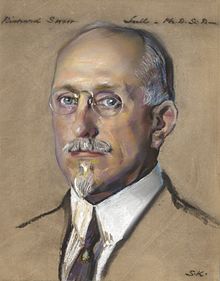
It is sometimes supposed that the cause of the extinction of the dinosaurs, carnivorous and herbivorous alike, might have been in their increased bulk. It is not even clear how the brontosaurs could bear their many tons’ weight of body on straight legs.
“The increased bulk necessitated their forsaking the strictly terrestrial habitation and becoming partly if not wholly water-borne.”
“These [Sauropoda] creatures waded, as their heavily ballasted limbs imply, or swam … but show no distinctively natatory adaptation.” [Lull]
For this reason the large brontosaurs and diplodocs are thought to be related to the class of amphibia, or reptiles, living party in water and partly on the land. The skeletons have no signs of adaptation to life in water, but their great weight on land demands this explanation about the amphibious behavior of these animals; in water their bodies would be less heavy. However, Brontosaurus was not an amphibian, but a land animal.
It is conjectured that the brontosaurs grew too heavy to walk on land; but why did they grow so heavy, if the law of evolution is a principle of adaptation to existing conditions?
“The cause of extinction is by no means clear.” [Lull]
The extinction was not gradual.
“The most dramatic and in many respects the most puzzling event in the history of life on the earth … is the change from the Mesozoic, Age of Reptiles, to the Tertiary, Age of Mammals. It is as if the curtain were rung down suddenly on a stage where all the leading roles were taken by reptiles, especially dinosaurs, in great numbers and bewildering variety, and rose again immediately to reveal the same setting but an entirely new cast, a cast in which the dinosaurs do not appear at all, other reptiles are mere supernumeraries, and the leading parts are all played by mammals of sorts barely hinted at in the preceding acts.”
[G.G. Simpson, quoted by Shuchert and Dunbar, Outlines of Historical Geology (N.Y., 1941), p. 230]
But a hint is given in the fact that the so-called Laramide revolution, accompanied by a folding of the Earth’s crust and the uplifting of mountains, marks the end of the Mesozoic era, or the era of the dinosaurs. It is characteristic:
The Mesozoic age terminated in a revolution that uplifted continents and dropped them in other places; and “the period of the extinction of the dinosaurs was coincident with the world-wide Laramide revolution.”
“Perhaps the extensive extinctions at the end of Cretaceus time are to be correlated in some way with the beginning of worldwide mountain uplifts, which eventually were to result in the modern great mountain systems — the Himalayas and the Alps, the Andes and the Rocky Mountains. This is known as the ‘Laramide revolution’ in earth history. However that may be, the empirical evidence shows that with the advent of Cenozoic history the mammals inherited the earth.” [ E.H. Colbert, Wandering Lands and Animals, p207 (N.Y., 1973)]
It should be very simple to imagine that the same catastrophe killed the dinosaurs. Cataclysms are not barred from Geology but they are regarded as slow processes; as a factor in biology, real cataclysms and revolutions have been disqualified since the theory of Darwin about slow adaptations and evolution became the standard view. Therefore the Laramide revolution folded the Earth’s crust and uplifted mountains, but did not affect the life of the dinosaurs, and the cause of their extinction is still being sought.
Regarding the problem of extinction, Lull notes that, “individual species [of dinosaur] are reported from rocks as high as the Lance [formation]. It is hardly conceivable that a few stragglers should survive, even in the more remote portions of the globe, for millions of years after the general extinction of the group, yet this is precisely what our records seem to show, unless there has been a misinterpretation of an extremely local remnant of older strata, as in the Ojo Alamo described by Gilmore, or the lack of recognition of true age, possibly of the lower members of an apparently continuous formation, as in Patagonia.”
“Gilmore has just described a form, which he calls Alamosaurus, from the Ojo Alamo beds of New Mexico, an undoubted sauropod, but in inexplicable association with Lance forms, long after the general extinction of the race. He compares measurements with those of Brontosaurus; the scapula of Alamosaurus was 65 inches long to 45 inches for that of Brontosaurus; the ischia, on the other hand, were nearly equal, showing again a brachiosaur-like beast.” [R S Lull, Organic Adaptation, op.cit., p. 276.]
In the great catastrophes, the large terrestrial animals had less chance to survive than the small ones; they could hardly find caves large enough to conceal them; if they found large caves, they thronged into them, and suffocated there or were crushed by the collapse of the caves. Many skeletons of dinosaurs are found in such large caves. Small animals could enter clefts of the rocks, or holes in the ground, and though their numbers were also decimated, relatively more of them could survive.
In the conditions that followed the catastrophe, the very few large dinosaurs which were left alive, were condemned to extinction as the result of violent alterations in practically all geophysical conditions; changes in magnetic fields, in temperature, in the composition of the atmosphere, in the length of the day and of the year, along with the change in the seasons, profoundly affected organic life.
Especially the increased weight of everything on the Earth, caused the bodies of the few remaining brontosaurs to become heavier than they could bear. Wading in water, though diminishing the load which ballasts the legs, is no real adaptation: the feet are heavily dragged and sink in the mud below the shallow water. Leaving the water, the animals must have felt the great weight of their bodies and the arresting effect of the mud.
If these animals were mammals, as conjectured, the carrying of young, because of the additional weight, must have been most disastrous for the female.
Only the monstrous sea-mammals of that age escaped total destruction, and their descendants live until today; these are the whales. They reach over one-hundred feet in length, and in weight they surpass the largest brontosaurs. If we only knew them as fossils, would we classify them as mammals?
Myth and Legend
It is remarkable that travelers of the second and possibly the first millennium before the present era, brought home these stories:
The ruler over the sea animals is Leviathan. His fins radiate brilliant light, its smell is foul. Leviathan spouts out water.
This description, one may guess, is of a whale. Ziz is the ruler over the birds; it is monstrous in size; its wings are so huge that unfurled they darken the Sun.
“Great bird Ziz slaps his wings and utters his cry, so that the birds of prey, the eagles and the vultures, blench.”
[L. Ginzburg, Legends of the Jews, I (Philadelphia, 1942), p. 28.]
The span of the wings of the pterosaurs ranged from 27 feet upwards to an incredible 69 feet, whereas the span of the wings of the large eagles is less than 10 feet.
Behemot (not to be confused with the animal that bears this name at present) is the most notable representative of the mammal kind. Behemot matches Leviathan in strength. In combat between the gigantic beasts, Leviathan kills by a blow of its fins, and Behemot kills by a lash of its tail. The modern paleontologists wondered at the largest land animal’s lack of weapons for attack or defense, which would have made it easy prey for every attacker, and supposed that the animal used its tail as its weapon.
Equally interesting is the legendary description of the gigantic female Reëm when heavy with young.
“Leviathan, Ziz, and Behemot are not the only monsters; there are many others, and marvelous ones, like Reëm, a giant animal, of which only one couple, male and female, is in existence… The act of copulation occurs but once in seventy years between them… The act of copulation results in the death of the male. He is bitten by the female and dies of the bite. The female becomes pregnant and remains in this state for no less than twelve years. At the end of this long period she gives birth to twins, a male and a female. The year preceding her delivery she is not able to move… For a whole year the animal can but roll from side to side, until finally her belly bursts, and the twins issue forth. Their appearance is thus the signal for the death of the mother reëm.” [Ginzburg, pp. 28-31.]
Fantastic as these accounts may seem, they may carry knowledge of dinosaurs or their contemporaries into historical times.
Reference: Kronos journal vII No2 p91
Opening Image: Cretaceous landscape by Karen Carr
End Image: 1927 mural by Charles Knight, American Museum of Natural History
